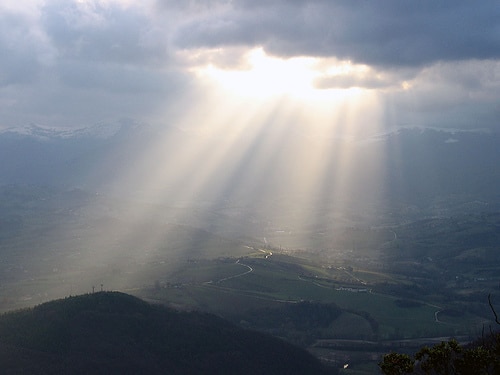
Get Up. Do Not Be Afraid.
In Matthew 17:1-9 it says this:
Six days later Jesus took Peter, James, and John his brother, and brought them to the top of a very high mountain. He was transformed in front of them. His face shone like the sun, and his clothes became as white as light. Moses and Elijah appeared to them, talking with Jesus. Peter reacted to all of this by saying to Jesus, “Lord, it’s good that we’re here. If you want, I’ll make three shrines: one for you, one for Moses, and one for Elijah.” While he was still speaking, look, a bright cloud overshadowed them. A voice from the cloud said, “This is my Son whom I dearly love. I am very pleased with him. Listen to him!” Hearing this, the disciples fell on their faces, filled with awe. But Jesus came and touched them. “Get up,” he said. “Don’t be afraid.” When they looked up, they saw no one except Jesus. As they were coming down the mountain, Jesus commanded them, “Don’t tell anybody about the vision until the Human One[a] is raised from the dead.”
I’ve been thinking a lot recently about changes; the big ones and the small ones. The ones we are ready for and the ones we seem to be pushed into. I am not generally a big fan of change. I have my favorite places to eat, my favorite places to shop. I don’t rearrange my furniture very often. It’s not that I’m unwilling to change, but I like the stability. But for me personally this has been a year of some large changes and it has me reflecting on what we can learn from times of change.
Several years ago now, I was laid off from a job I’d been in for six years. It was a rough time. I was angry and hurt. I was scared for the future. I felt unmoored. I hated that I wasn’t leaving on my own terms. But getting laid off turned out to be the push that I needed. It served to catapult me into a new future; a future that turned out even better than I could have imagined it.
But when it happened I didn’t feel ready. At the time it didn’t feel like a good thing. In the midst of the fear and the hurt, I didn’t want to hear that “it was for the best”.
Have you ever had an experience like that? An experience where things changed even when you didn’t want them to? Or where you knew things had to change but you didn’t feel ready? What did you feel like? What did you do?
In this story from the Gospel of Matthew we find the disciples in a similar position and it lets us know that we are not alone in our fear and our desire for things to stay the same.
In this passage Jesus takes his closest friends to the top of a mountain and they have this amazing encounter together. They see the prophets and they hear the voice of God. They discover something new about their friend and their leader; he is revealed to them in all of his glory. And I think their response is telling. Instead of wanting to run back down the mountain and tell everyone, their first response; their immediate reaction, is to want to build shelters and stay put.
They want to stay in the space where they had this amazing experience. They wanted to hold on to that feeling for as long as they could. They wanted to make it permanent.
There is nothing inherently wrong with wanting things to stay the same. There is nothing inherently wrong with wanting to stay in a job that you enjoy and that feels safe, or to stay in the home that you’ve built, or to go to your favorite places over and over again. Sometimes we long for comfort. In a world that is full of uncertainty and complexity, it can be nice to have something we can count on.
But what if what is comfortable and safe is holding us back from what God is trying to do in and through us?
Jesus told his friends while they were on that mountain that they couldn’t stay there. Jesus told them to get up. To not be afraid. And then he walked with them down the mountain and they continued on their journey. It was a journey that would take them to Jerusalem where Jesus was killed.
I wonder if, in those three days when Jesus was dead and the disciples didn’t know what was coming next, if they thought back to this moment on the mountain. I wonder if they thought that they should have tried harder to keep Jesus there. If they all should have stayed safe. In the midst of their pain and grief they probably thought of a million ways they could have done things differently.
Sometimes the closing of a chapter brings pain and grief. We wanted things to turn out differently. We wanted to keep going. We wanted to stay together. Sometimes we have situations where we can’t see what the future is bringing us: We are in the valley of unknowing. We don’t know what our work here means yet (we don’t have enough distance to see). We don’t know what God will continue to do in and through us. We don’t know what’s next.
But Jesus’ message still rings in our ears: Get up. Do not be afraid.
Without Jesus leaving the mountain, without his journey to Jerusalem, without his death and then his resurrection, we wouldn’t be sitting here in this room. Had Jesus stayed safe on that mountain there is a good chance his message wouldn’t have spread very far. Because it was the events of his death and resurrection that gave his followers the courage and the inspiration to spread the message that God was doing a new thing and that anyone who wanted to could be a part of it.
And that’s the good news for us, too. We are a people who (at least on our good days) believe in resurrection. We believe that even when it seems that all hope is lost, even when it seems that we are at the very end of something, even when it seems that there is nothing left, that God is still working and God will do miraculous things. God will bring new life out of dead places.
But it often doesn’t look like we expect it to. We don’t always know what God is going to do next. But I know that God is doing something. God is preparing all of us to continue to do ministry in new ways. Something is happening that is making space for something new to be born. In us. In the world. It might not look like what we’ve tried to build over the last several years; but I believe that God is doing something here. God is going to continue to work in and through us. Our mission doesn’t change; to be transformed people, transforming the places around us.
We continue to spread the message of a God of love and compassion who welcomes all people and invites all of us to be a part of the work of bringing about the Kingdom of God.
Jesus says to us get up, don’t be afraid. Don’t be afraid to walk into the unknown places. Don’t be afraid of the future. Don’t be afraid of the discomfort that comes in the midst of change. Don’t be afraid.
We belong to God. We are a people of the resurrection. We believe that new things can come from even the saddest of endings. So today we get up. We walk down the mountain, knowing we are beloved children of God and that we can have courage to face whatever is next.





